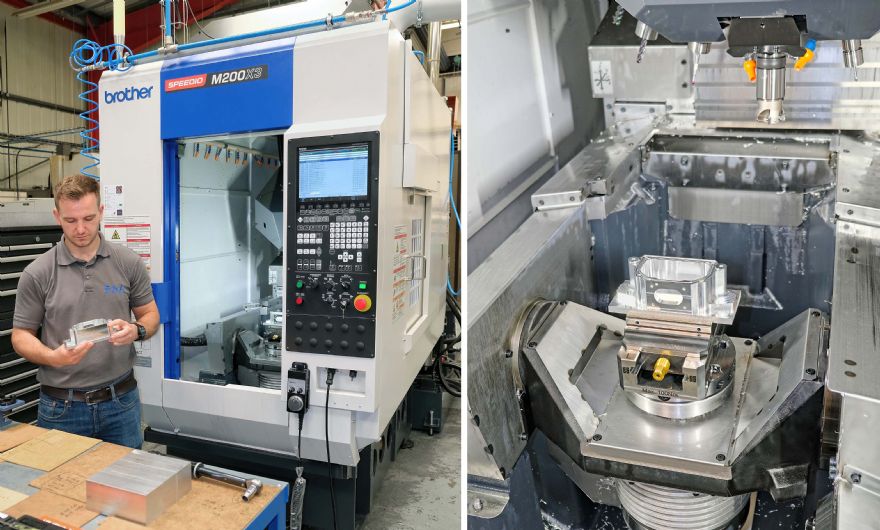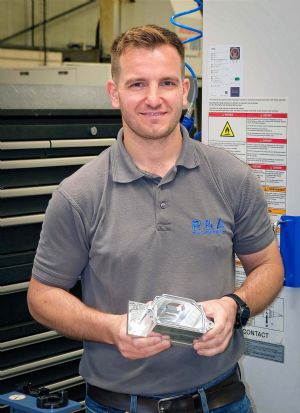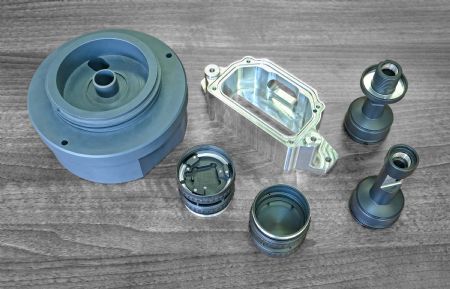 Ed Piotrowski holding an aluminium EV engine terminal block machined on R&A Engineering’s Brother five-axis Speedio M200X3 machining centre, which is also capable of in-cycle turning operations
Ed Piotrowski holding an aluminium EV engine terminal block machined on R&A Engineering’s Brother five-axis Speedio M200X3 machining centre, which is also capable of in-cycle turning operationsIn early 2023, Aylesbury-based
R&A Engineering Ltd won a contract to produce several hundred aluminium parts per month. These entailed six variants used in sensor assemblies that optimise the orientation of wind turbines to maximise the power they generate; and because the job was tying up a pair of the sub-contractor’s BT40-taper vertical machining centres (VMCs) and impacting its ability to take on other work, it was decided to transfer production to a 30-taper high-speed VMC.
This decision resulted in an order being placed for a Brother M200X3 five-axis VMC with a 16,000rev/min spindle; the machine was delivered by the Japanese manufacturer’s sole agent in the UK and Ireland —
Whitehouse Machine Tools Ltd, Kenilworth. Since being installed, this Brother machine has, on average, halved the time it takes to complete post-anodising milling, drilling and tapping operations on the six components. This equates to the equivalent amount of machining undertaken by the two 40-taper VMCs, which are now free to carry out other work.
E

Mr Piotrowski, R&A’s operations manager (pictured left), said: “Although we approached a couple of 30-taper VMC suppliers, Whitehouse’s proposal was the obvious choice, even though we have never bought a machine from the supplier before. Like ours, it is a family-run firm and has a similar ethos to ours regarding high-quality service, which was obvious when we visited its showroom in Kenilworth a couple of times for demonstrations. The Brother performs very well, with cycle times that are between 1.5 and 4.5min; this is half of what they were before — and the ±0.05mm tolerance is held all day long without any problem.”
Established in 1985 by Mr Piotrowski’s parents and currently employing 18 staff, R&A has grown some 50% since 2021; the company has also invested £800,000 in machine tools during the past couple of years and is looking to automate production wherever possible in both the turning and milling sections. It says the rationale is twofold: the first is to be able to take on extra work without compromising existing, long-running contracts; the second is to be ‘more cost-competitive on the world stage’ and ‘accelerate the flow of work that is already being reshored from Asia and elsewhere in increasing quantities’.
‘Nimble machining’Mr Piotrowski offers some ‘interesting insights’ as to why a sub-contractor should invest in a 30-taper VMC, bearing in mind that an ‘adage in contract manufacturing’ is that one never knows what work will come through the door, and that the wider applicability of a 40-taper machine — due to its size and power — would therefore seem to make more sense.
“The first advantage of a nimble milling machine with the smaller-diameter tool interface is high speed production, which translates into greater profitability. Not only does the elevated spindle speed combined with up to 30m/min cutting feed rate provide generous metal removal rates, but idle times are also lower due to 50m/min rapids in X, Y and Z — and tool change is under 1sec.
“However, another benefit is the vastly lower power consumption of 30-taper machines; the M200X3 draws less than 10kVA, versus what is typically 50kVA for a 40-taper VMC — or perhaps even more if it is an old machine. Energy bills are therefore lower, and if a factory is close to its power supply limit the lower kVA rating is a godsend.”
Reviewing the characteristics of the respective BT spindle machines, Mr Piotrowski says that while power and rigidity are higher in a 40-taper VMC, modern, smaller-taper counterparts such as the Brother have a ‘reasonably well specified’ spindle motor with good torque, even in the medium- to high-speed range.
“The drive motors are also consistent with robust machining and face-and-taper-contact tool retention assists further; and while the machining of light alloys is really the province of this type of machine, using modern CAM software to create intelligent cycles involving light depths of cut and high-speed contouring means that tough and difficult-to-machine metals can also be tackled.”
Turning capabilityHe went on to say that the M200X3 has a further advantage for OEMs and sub-contractors alike. “Being equipped with a torque motor to drive the rotary table, this machine not only allows a component to be indexed for prismatic machining but also rotated at up to 2,000rev/min for turning operations with a static turning tool in the spindle.

Pictured right: A selection of parts machined by R&A Engineering on the Brother VMC
“Completing this second operation in-cycle without the need to re-fixture the part in a lathe simultaneously raises accuracy and productivity. The mill-turn capacity in an impressively small footprint holds a lot of potential for our shopfloor.
“Take the wind turbine sensor job for which the machine was purchased. Currently all six parts undergo turn-milling on a lathe before being sent out for anodising. The Brother is only required to remove the insulative anodic layer in certain areas to provide electrical conductivity; but, with its turning capability, all the parts could be completely machined on the Brother and we are considering this possibility, although doing so would require automated component handling to be retrofitted.”
R&A is not only seizing opportunities in the renewable energy sector but also taking advantage of growth in vehicle electrification, having already produced two aluminium parts on the Brother VMC. One is an EV (electric vehicle) engine terminal block, which is milled, drilled and tapped in a 20min cycle. The other is an engine part has been transferred to the M200X3 from a 40-taper machine, with the result that it is now machined in 8min rather than 12min.
Mr Piotrowski is already planning the next job for the Brother. Water-purification work accounts for about one-third of the sub-contractor’s turnover, and one of the parts — machined from Ertacetal, an electrically conductive plastic — is currently turned and milled in four setups on three other machine tools. On the Brother it will come off complete after two setups.